Georgia
On Traditional Vocal Polyphony in Georgia
Georgia (in Georgian “Sakartvelo”) is a mountainous country of about 70 000 km2 on the eastern side of the Black Sea. Autochthonous residents of the Transcaucasia, Georgians still speak the Georgian language, which has survived from the epoch of the pre-Indo-European languages. Being surrounded by the highest mountains of Europe (reaching at several points more than 5,000 meters, like Shkhara in Svaneti, 5201m, or Kazbek in Khevi, 5047m), the Caucasian mountain gorges represented the ideal “hiding place” from outer influences for isolated populations for many centuries.
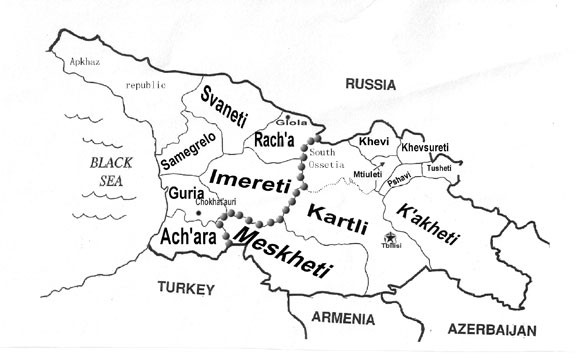
Fig. 1. Ethnographic map of Georgia
(Tsitsishvili, 2004. Used with permission)
Georgia is usually divided into fifteen ethnographic regions. Some of them are very big, such as Kartli, Kakheti, Mekheti or Imereti, but some of them are very small – particularly in the northeastern part of Georgia.
In the following we will first briefly discuss the general characteristics of Georgian polyphony (for more detailed surveys see Jordania, 2000, 2006), and then the main stylistic features of the major regions.
- Unlike a few countries in Europe, where the tradition of polyphonic singing is represented only in some of the regions, the whole of Georgia is one big group of closely related polyphonic traditions;
- Two-, three- and four-part singing is spread through different regions of Georgia, with two-part singing mostly in the mountainous Northeastern regions of eastern Georgia, and four-part singing in the Southwestern part of Georgia. Three-part singing is the most widespread throughout Georgia;
- There is no tradition of group unison singing in Georgia, so monophonic songs are performed by individual singers; monophonic singing occurs only when the performer is alone (during work in a field, or alone on a road, or putting a baby to sleep, or lamenting alone). If, for any reason, the person is not alone, then even the traditionally monophonic songs can easily turn into polyphonic ones.
- The individual singers always sing main melodic parts, and the group usually sings the bass. In the tradition of “trio” songs (common in some regions of western Georgia) the bass is also performed solo. In four-part western Georgian harvest songs there are actually two basses – one is a pedal drone in the middle of the texture, and another is a melodically active low base. Both basses are performed by a group of singers;
- Drone (sustained pedal note or the rhythmic repetition of the same note) and ostinato (repetition of the same short phrase by one of the parts, usually bass) are the two most important principles of polyphony in all regions of Georgia;
- Sharp dissonant chords (based on seconds, fouths, fifths and sevenths intead of thirds) are very characteristic for Georgian traditional polyphony (Aslanishvili, 1970 [1950]).
Eastern Georgia consists of two of Georgia’s biggest ethnographic regions – Kakheti and Kartli and five (some researchers maintain six) small mountain regions in the Northeastern part of Georgia: Khevsureti, Pshavi, Tusheti, Khevi, Mtiuleti (and according to some classifications – Gudamakari as well. See Garakanidze, 1991).
The plain regions of eastern Georgia – Kartli and Kakheti - have always been historically central for Georgia. The best-known feature of eastern Georgian traditional singing is the presence of long, “drawn-out” table songs from Kartli and particularly Kakheti. These songs are performed by the two melodic lines singing against a background of a steady pedal drone on “O”. The leading melodies are always performed by the individual singers, and the drone by all the others.
The leading melodic lines have a wide range (about an octave or wider) and of these two melodies one is usually a bit higher than the other. The lower melody is considered to be the leading part of the song (mkmeli, “the one who speaks”, or the “first voice”), who usually starts a song, followed by the higher “second voice” or modzakhili (the one who follows). The main task of both lead singers is to ornament their melodic lines. The tempo is usually slow, and the songs are mostly performed in free (rubato) time. Today these two parts quite often sing in parallel thirds, although recordings of the first half of the 20th century show that the coordination between these two melodic lines was much freer. Some major sections of eastern Georgian table songs are performed in two parts, as the leading singers sometimes alternate with each other. Here is an example of East Georgian long table song:
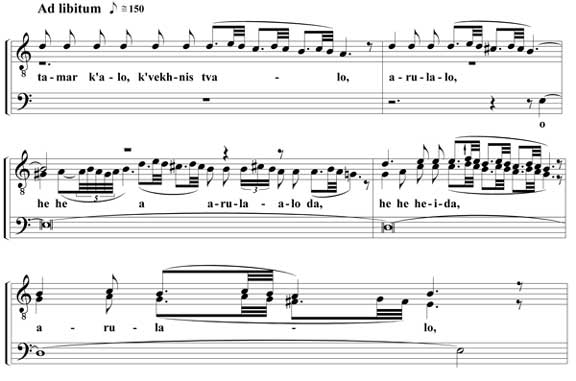
Ex. 1. Opening section of “Tamar Kalo” [Maiden Tamar].
(Garakanidze, Jordania, 2004:114)
[Important: in all musical examples the top parts, written in a treble clef,
must be performed an octave lower, as indicated by the clef itself.]
Although the base is a pedal drone in eastern Georgian “long” table songs, it does move, leading to key changes (modulations). These occasional base moves are extremely important for the overall form of a song. These key changes, or modulations, make up the main tonal body of the table song. The scale in East Georgian table songs is very consistent – virtually always the same diatonic scale, commonly known as Mixolydian.
Long table songs are not the only genres of polyphonic music in eastern Georgia. There are plenty of other singing genres here as well – from horse-riding to love, healing, working and round dances. Interestingly, none of them are performed in the style of the long table songs. Although the moderate use of ornaments is encountered in most of the eastern Georgian genres (particularly in the solo, opening sections), the rhythm is usually precise, the songs do not employ the complex system of modulations, pedal drone is mostly replaced by the rhythmic drone, or ostinato, and the verbal text is often rendered by all three parts simultaneously. Here is an example of this singing style from eastern Georgia:
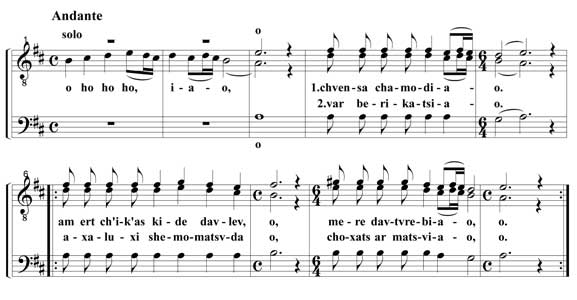
Ex. 2. Gigini [humming] lyrical song (Garakanidze, Jordania, 2004:5)
Polyphonic singing traditions in the northeastern ethnographic regions of Georgia are not as sophisticated as in Kartli and Kakheti. Two-part singing dominates here. The northeastern dialectal regions are usually united into two groups: the Tusheti, Pshavi and Khevsureti are generally regarded as more archaic regions (especially Khevsureti), and the Khevi and Mtiuleti are considered to be more advanced. The singing traditions of Khevsureti are of particular interest. Their rudimental two-part drone polyphony is traditionally regarded as the most archaic surviving element of the ancient Georgian singing tradition (Chkhikvadze, 1961; Araqishvili, 1905, 1916). The alternative view also exists that in Khevsureti we have a case of a degradation and disappearance of more advanced traditions of polyphonic singing (Jordania, 2006:198-200). Pshavi could be the classical representative of polyphonic singing of this small group of regions from the northeastern region of Gergia, with two-part drone singing, antiphon between the two soloists, major second moves of the drone, and the typical cadences on the unison. Tusheti is known as the region of the seasonal shepherd-travelers with interesting ties to the neighboring North Caucasian peoples, and some features of their musical traditions are unusual among other Georgian regions. Khevi and Mtiuleti represent a more advanced region, where two-part singing is well established and there are songs where three-part singing plays an important role.
Meskheti is located in the southern part of central Georgia. This is the only region of Georgia where (possibly mostly due to demographic reasons) the tradition of polyphonic singing began disappearing during the 20th century and was finally lost in the 1970s. According to the recordings made from the last survivors of the local polyphonic tradition, the Meskhetian polyphonic style was close to the eastern Georgian (Kartlian and Kakhetian) style, with the drone (both pedal and rhythmic), and with “long” table songs with ornamented melody (Magradze, 1986).
Georgians also live outside Georgia’s eastern border, in the district of Kakhi in neighboring Azerbaijan. This region is also known as Saingilo. The Georgian population of Saingilo is partly Christian and partly Moslem. According to the limited information, the tradition of polyphonic singing (in harvest songs) was still alive in Saingilo in the 1920s and 1930s. Some of their contemporary monophonic song melodies combine the elements of the melody and the bass. The group of young local patriotic males was still singing new songs in the traditional Georgian style of drone three-part polyphony in the 1990s.
Western Georgia is well known for its traditional contrapuntal polyphony, although the drone and ostinato play an important role in western Georgian polyphony as well.
Western Georgia consists of six (according to some views – seven) so-called musical dialects. Unlike eastern Georgia, where we have three asymmetrically big plain regions and several much smaller mountainous regions, the differences between the region’s sizes are not as large in western Georgia.
The musical differences between eastern and western Georgia are quite obvious:
Rhythmically, western Georgian polyphonic songs are always well defined (no free metres, usual in eastern Gergian table songs and solo work songs);
Melodic lines never use the rich melismatic ornamentation which is so characteristic of eastern Georgia and particularly for the genre of ‘long” table songs;
Instead of two- and three-part singing in eastern Georgia, western Georgia represents the world of three- and four-part polyphony;
The drone is present in western Georgia, but it is mostly a rhythmic drone, and besides, in some of the most complex songs the drone is in the middle of the four-part polyphonic texture (instead of being in the lowest part only in eastern Georgia);
Unlike eastern Georgian drone and ostinato bass, the bass part in some West Georgian regions can be extremely active melodically, and sometimes is performed by a soloist.
The tradition of “trio song” (three-part songs sung by three individual singers) is also unique to some regions of western Georgia;
The yodel is present only in western Georgia;
Triple metres ¾ and 3/8, very popular in eastern Georgia (particularly in certain round dances), are rare in some regions and completely absent in other regions of western Georgia.
The best-known tradition from western Georgia is the highly developed tradition of contrapuntal polyphony in Guria. Here is the example of four-part polyphony of the harvest song Naduri with an interesting mixture of contapuntal, drone and ostinato types of polyphony:
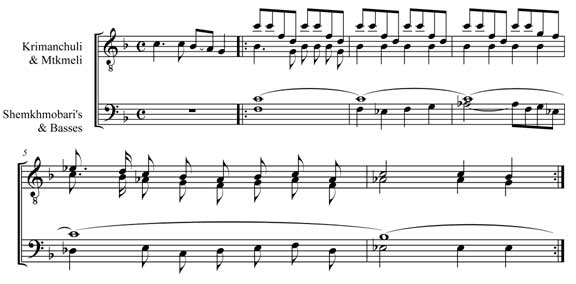
Ex. 3. Naduri. Final section of a harvest song
(traditionally performed during hoeing on maize fields. Jordania 2006: 83 and 87)
In this four-part section we can see: (1) Krimanchuli on the top (yodel), (2) shemkhmobari (a specific pedal drone in the middle of the texture) (3) mtkmeli, the leading voice, who starts the song and who is the only part that recites the text, and (4) Bani the lowest voice, which is melodically very active, and mostly sings a perfect fifth below the pedal drone of shemkhmobari. Out of these four parts, two of them (shemkhmobari and the bass) are traditionally performed by the groups of singers, and the two other parts (krimanchuli and mtkmeli) are performed by individual singers.
A mixture of different compositional principles is in fact very common for the Georgian (and particularly western Georgian) tradition of polyphonic singing. Tamaz Gabisonia distinguished several such types of Georgian polyphony, based on a mixture of different compositional principles of polyphony, in a special group of synthesis types of polyphony (Gabisonia, 1988:12).
Wide improvisational possibilities of the bass part to create a wide range of melodic and harmonic versions in trio songs attracted the most talented Gurian singers, and for this reason most of the well-known Gurian singers were known as bass performers (N. Jordania, 1985).
Different western Georgian dialects also feature elements that give them a special place in the tapestry of Georgian polyphonic tradition. The Imeretian dialect (the biggest region in western Georgia), for example, is famous for its dynamic riders’ songs and for the flourishing tradition of European-style urban polyphonic songs; the Megrelian dialect is known for its combination of sharp dissonances with a very soft manner of singing (Megrelians also speak their own language); the Acharian dialect (the only region with Moslem Georgians in western Georgia) has two very different styles: (1) the so-called Kobuletian region is very close to the Gurian style of complex three- and four-part polyphony (according to some scholars, residents in this part of Acharians are Gurians who were under Turkish rule and changed their religion), and (2) the so-called Shavsheti region with a two-part polyphonic singing tradition (the only region with two-part singing in western Georgia. Garakanidze, 1991). Svaneti (particularly the so-called “upper Svaneti”) holds a special place in Georgian ethnographic literature. This is the most mountainous region of Georgia, completely cut off for a good half of the year from the rest of the world. Svanetians have their own linguistically very archaic Svanetian language, archaic non-rhythmic poetry, and they sometimes still use their impressive 8-12th century family towers. Together with this variety of archaic features, Svanetians have quite outstanding polyphonic traditions (Araqishvili, 1950), featuring exclusively three-part close dissonant-based antiphonal polyphony that grow into round-dances. The melodic range of Svanetian songs is very narrow (usually within the fourth); unlike most other Georgian singing traditions, where the mens’ and womens’ singing is gender-segregated, in Svaneti the men and women often sing and dance together.
Racha, neighbouring Svaneti, is another very interesting region, although archaic elements in language, poetry, ethnography and musical traditions are not as evident and as deep in Racha as in Svaneti. Rachian men and women also often sing together like Svanetians, and melodies of the so-called “mountain Racha” group (geographically and ethnographically closest to the Svanetians) also have a small range. But unlike Svanetian singing, at least some Rachian songs display obvious influences of the eastern Georgian singing style (pedal drone, mildly ornamented melody and specific modulations). Unlike the Svanetians, who still widely use dialects of their own mostly unwritten Svan language, Rachians use the Georgian language.
Polyphony in religious music. The eastern Georgian state Iberia was among the first states of the world to officially become Christian (337). Georgian historians and musicologists (Javakhishvili, 1938; Iashvili, 1977) believe that in the first few centuries the Christian rites were performed in Greek with monophonic singing. In around the 7th or 8th centuries the Georgian language and polyphonic singing tradition must have penetrated the church. According to written sources, polyphonic singing was well established in Georgian liturgy by the 10-11th centuries (Javakhishvili, 1998 [1938], Iashvili, 1977). In the 11th century, when the Greek orthodox canonic liturgy was translated into Georgian, special professional help was sought to make them polyphonic (possibly three-part). The Georgian linguist Zurab Chavchavadze made a suggestion that the term “Organ”, used in medieval Georgian literature to describe the expertise of the knowledgeable person who was put in charge of making the “alien Greek sound closer to Georgian”, was denoting not a musical instrument, but “Organum”, the medieval term for the early European type of vocal polyphony (Chavchavadze, 1993:34-36). Interestingly, the term “Organa” from the well-known medieval literary source of Giraldus Cambrensis (Descriptio Cambriae, 1194) was an enigma for British musicologists as well. Lloyd Hibberd’s interpretation that “Organa” was not an “Organ” or “Instruments”, but “polyphony” – “Organum” (Hibberd, 1955) was gladly accepted by most music historians.
In the works of the Georgian philosopher Ioane Petritsi (11-12th centuries), the author makes symbolic parallels between the Christian Trinity and the three parts of the Georgian church singing tradition, and mentions the then-existing names of three parts: “Mzakhr”, Zhir”, and “Bam” (Iashvili, 1977).
The religious music of Georgia, like traditional music, has been traditionally divided into two branches – eastern Georgian and western Georgian, although today Georgian scholars prefer to speak about different local schools, rather than east-west differences (Shugliashvili, 2000). After the “Golden Age” of the Georgian state and culture (11-12th centuries), hard times brought numerous invasions during the 13th-18th centuries. Maybe the hardest time for the Georgian church-singing tradition was the first half of the 19th century, when Georgian singing was banned in Georgian churches by Russian authorities and the Georgian language was banned at schools. By 1860, with the rising of nationalist movements throughout European countries, a special committee was created in Georgia to look after the Georgian church-singing tradition. By the 1860s representatives of one school in eastern Georgia and three schools of western Georgian church singing were still alive and remembered the bulk of the repertoire. More than 5000 church songs were transcribed in contemporary notation. A ban on any kind of religious studies, imposed by Soviet government, halted the study of Georgian church songs for most of the 20th century. Today this is one of the active spheres of Georgian musicology.
Traditional and professional (religious) polyphony in Georgia have always influenced each other. It was traditional polyphony that influenced the initial monophonic tradition of early Christian church singing and turned it polyphonic (Javakhishvili, 1938; Iashvili, 1977). This was the case in many other countries of Europe (like Bulgaria, Russia, or Northern European countries). Good church singers were usually good experts in traditional music, and they would sing both in the church and at social events. Church songs were always performed at these social events (usually at the beginning of the supra feast).
Here is a typical example of a western Georgian church song:
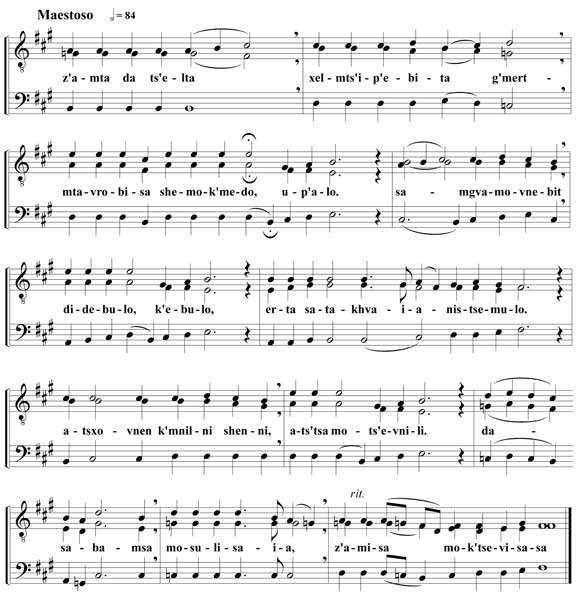
Ex. 4. Zhamta da Tselta. [Epochs and years]
(Garakanidze, Jordania, 2004:110)
Here is an example of an eastern Georgian church song:
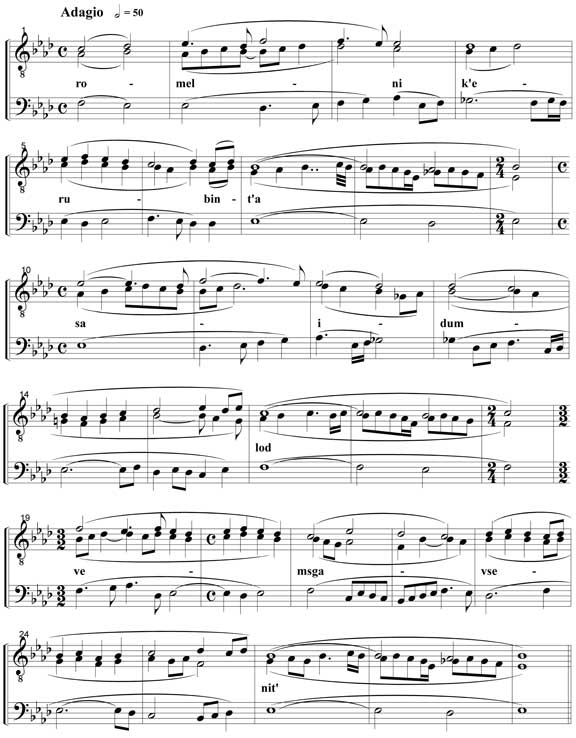
Ex. 5. Romelni Kerubinta. [Cherubs] Eastern Georgian church song. (Garakanidze, Jordania, 2004:107)
Urban Polyphonic Traditions
Besides older rural traditional polyphony and religious polyphony, there are relatively recent traditions of urban music and urban polyphony as well. The urban singing style in Georgia must have started with the creation of the first cities on the territory of Georgia. Being on the crossroads between Asia and Europe, Tbilisi (capital of Georgia for the last 1600 years) became a cultural capital of Transcaucasia and harbored an array of extremely talented musicians from different backgrounds (mostly of Middle Eastern ethnic origin, and particularly Armenian musicians). As a result of this interaction with Middle Eastern music, eastern melodies with ornamented melodies and augmented seconds appeared in Georgian cities. Part of these traditions remained very close to the Middle Eastern original style and had a somewhat smaller circle of admirers, but part of this music became very popular among a wider range of Georgians. These Middle Eastern songs, originally monophonic melodies, often became polyphonic (three-part) in Georgia. This style, often connected to the sounds of duduk emsembles, was (and still is) distributed in Tbilisi and a few other cities of eastern Georgia.
Besides this style, known under the name of the “Eastern (or “Oriental”) branch of Georgian urban music”, there was another urban singing style in Georgia, influenced by European professional music. This style appeared much later, with the first contacts of Georgia with European music in the form of guitar-accompanied Russian romance and performances at the Opera House, which opened in Tbilisi in 1850 and became very popular almost overnight. Georgians from both the eastern and western parts of Georgia became very enthusiastic about this new music and new harmonies. Many of the popular arias of Italian operas were rearranged in three-part urban a cappella style and are still sung (with Georgian lyrics) as a part of the Georgian urban tradition.
Two sub-types of the western branch of urban music became popular very quickly: (1) guitar-accompanied lyrical songs, and (2) a cappella choral songs. Both of these traditions are mostly three-part (sometimes the fourth part can be added as well). The two top parts move mostly in parallel thirds (and sometimes sixths), with the main melody in the middle part, and the bass mostly follows the European major-minor harmonic system.
Araqishvili wrote at the beginning of the 20th century that the urban singing tradition was having a negative influence on Georgian traditional polyphony. This influence was mostly felt in the increase of parallel thirds between the two top melodic parts (instead of the traditional more adventurous and often dissonant coordination between the melodic parts).
The general popular perception of Georgian traditional polyphony is that it is exclusively a men’s tradition. Men sing the most complex polyphonic songs. Women sing mostly family-circle songs: lullabies, dirges, and some older ritual songs. Georgian women’s singing is polyphonic as well (mostly two and three-part drone polyphony), although not as complex and technically developed as the men’s tradition (Zumbadze, 2000.
Several generations of Georgian musicologists and ethnomusicologists from the end of the 19th century, as well as non-Georgian scholars (R. Lach, M. Schneider, S. Nadel, E. Emsheimer, S. Ziegler) contributed to the study of Georgian traditional and liturgical polyphony. More than 20 years of scholarly tradition of organizing international conferences and symposia on traditional polyphony, held in Georgia from 1984 onwards, and the establishment of the International Research Centre for Traditional Polyphony (with the help of UNESCO) in 2002 greatly contributed to the flow of finances, technical equipment and renowned international scholars, experts in traditional polyphony, to Georgia.
References
- ARAQISHVILI, DIMITRI. 1905. [Short review of development of Georgian (Kartlian and Kakhetian) folk songs.] Moscow Commission of Music and Ethnography. Vol. 1, Moscow: K. Menshov. (In Russian)
- ---- 1916. [“Georgian folk-musical culture.”] In Moscow Ethnographic and Anthropological Commission,5. Moscow: G. Lissner and S. Sobko. (In Russian)
- ---- 1950. [Svanetian folk songs]. Tbilisi: Khelovneba. (In Georgian)
- ASLANISHVILI, SHALVA. 1970 [1950]. Harmony of the Kartlian and Kakhetian folk choir songs. 2nd ed. Tbilisi: Ganatleba. (In Georgian)
- CHAVCHAVADZE, ZURAB. 1993. Literature studies, critics, translations. Tbilisi: Mertskuli. (In Georgian)
- CHKHIKVADZE, GRIGOL. 1961 Georgian folk songs (Editing and introduction). Tbilisi: Sabchota Sakartvelo. (In Georgian and Russian)
- GABISONIA, TAMAZ. 1988. Compositional principles and types of Georgian folk polyphony. In Problems of polyphony of Georgian music. Editor in chief Rusudan Tsurtsumia, pp. 3-17. (In Georgian)
- GARAKANIDZE, EDISHER. 1991. Musical dialects of Georgian traditional music. PhD, Tbilisi Theatrical Institute. (In Georgian)
- GARAKANIDZE, EDISHER, and JOSEPH JORDANIA. 2004. 99 Georgian Songs. (Introduced by Edisher Garakanidze, song notes and translations by Joseph Jordania) Collection of songs with notes. Edited by Joan Mills at the Centre for Performance Research, UK. BlackMountain Press
- HIBBERD, LLOYD. 1955. “Giraldus Cambrensis and English ‘Organ’ music”, JAMS, VIII:208-212.
- IASHVILI, MZIA. 1977. On the problem of Georgian polyphony. Tbilisi: Khelovneba. (In Georgian)
- JAVAKHISHVILI, IVANE. 1998 [1938]. The basic questions of Georgian music. In Ivane Javakhishvili. Works in 12 volumes. Vol. 9. Edited by Gulbat Toradze and Joseph Jordania. Tbilisi: Metsniereba (In Georgian)
- JORDANIA, JOSEPH. 2000. Georgia. In The Garland Encyclopedia of World Music. Vol. 8, Europe. Edited by Timothy Rice, James Porter and Chris Goertzen, pp. 826-849-269. New York: Garland Publishing.
- ---- 2006. Who asked the first question? The origins of human choral singing, intelligence, language and speech. “Logos”, Tbilisi State University
- JORDANIA, MINDIA. 1972. “On the problem of ‘modzakhili’ – high base”, in Collection of articles of Tbilisi State Conservatory. Editor in Chief Alexander Shaverzashvili, pp. 103-126. Tbilisi State Conservatory. (In Georgian)
- JORDANIA, NUGZAR. 1985. Role of the base in Gurian polyphonic songs, Sabchota Khelovneba 9:36-42 (in Georgian).
- MAGRADZE, VALERIAN. 1986. Meskhetian folk songs. Tbilisi: Khelovneba. (In Georgian)
- SHUGLIASHVILI, DAVID. 2000. On polyphony of Georgian Hymns. In Problems of folk polyphony. Materials of the International Conference dedicated to the 80th anniversary of the V. Sarajishvili Tbilisi State conservatory. Editor in Chief Rusudan Tsurtsumia, pp. 171-180.
- TSITSISHVILI, NINO. 2006. “’A Man Can Sing and Play Better than a Woman’: Singing and Patriarchy at the Georgian Supra Feast.” Ethnomusicology 50 (3): 452-493.
- ZUMBADZE, NATO. 2000. “Regularities of polyphony in Georgian women’s traditional songs”, in Materials of the international Conference “Problems of Traditional Polyphony”, dedicatred to the 80th anniversary of Tbilisi State Conservatory. Editor in Chief Rusudan Tsurtsumia, pg. 106-120. (In Georgian with English summary)






